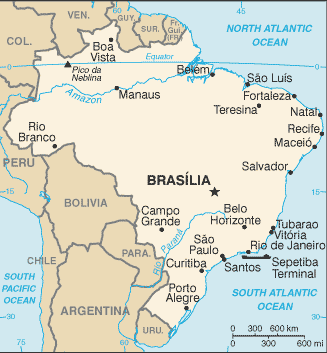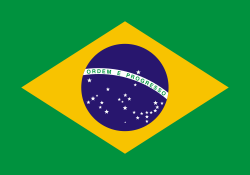Federative Republic of Brazil
Related Categories:
 Brazil - Fotw
Brazil - FotwThe celestial sphere on the republican standard is a portrait of the sky of Rio de Janeiro on the night of 15 November 1889.
www.fotw.us/flags/br.html Brazil - wikipedia.org
Brazil is characterized by the extensive low-lying Amazon Rainforest in the north and a more open terrain of hills and low mountains to the south — home to most of the Brazilian population and its agricultural base.
en.wikipedia.org/
With its estimated 186 million inhabitants, Brazil has the largest population in Latin America and ranks fifth in the world. The majority of people live in the south-central area, which includes the industrial cities of Sao Paulo, Rio de Janeiro, and Belo Horizonte. Urban growth has been rapid; by 2005, 81% of the total population was living in urban areas. This growth has aided economic development but also has created serious social, security, environmental, and political problems for major cities.
Six major groups make up the Brazilian population: the Portuguese, who colonized Brazil in the 16th century; Africans brought to Brazil as slaves; various other European, Middle Eastern, and Asian immigrant groups who have settled in Brazil since the mid-19th century; and indigenous peoples of Tupi and Guarani language stock. Intermarriage between the Portuguese and indigenous people or slaves was common. Although the major European ethnic stock of Brazil was originally Portuguese, subsequent waves of immigration have contributed to a diverse ethnic and cultural heritage.
From 1875 until 1960, about 5 million Europeans immigrated to Brazil, settling mainly in the four southern states of Sao Paulo, Parana, Santa Catarina, and Rio Grande do Sul. Immigrants have come mainly from Italy, Germany, Spain, Japan, Poland, and the Middle East. The largest Japanese community outside Japan is in Sao Paulo. Despite class distinctions, national identity is strong, and racial friction is a relatively new phenomenon. Indigenous full-blooded Indians, located mainly in the northern and western border regions and in the upper Amazon Basin, constitute less than 1% of the population. Their numbers are declining as contact with the outside world and commercial expansion into the interior increase. Brazilian Government programs to establish reservations and to provide other forms of assistance have existed for years but are controversial and often ineffective.
Brazil is the only Portuguese-speaking nation in the Americas. About three quarters of all Brazilians belong to the Roman Catholic Church; most others are Protestant , members of a growing evangelical movement, or follow practices derived from African religions.
Pedro Alvares Cabral claimed Brazil for Portugal in 1500. The colony was ruled from Lisbon until 1808, when Dom Joao VI and the rest of the Portuguese royal family fled from Napoleon's army, and established its seat of government in Rio de Janeiro. Dom Joao VI returned to Portugal in 1821. His son declared Brazil's independence on September 7, 1822, and became emperor with the title of Dom Pedro I. His son, Dom Pedro II, ruled from 1831 to 1889, when a federal republic was established in a coup led by Deodoro da Fonseca, Marshal of the Army. Slavery had been abolished a year earlier by the Regent Princess Isabel while Dom Pedro II was in Europe.
From 1889 to 1930, the government was a constitutional republic, with the presidency alternating between the dominant states of Sao Paulo and Minas Gerais. This period ended with a military coup that placed Getulio Vargas, a civilian, in the presidency; Vargas remained as dictator until 1945. Between 1945 and 1961, Jose Linhares, Gaspar Dutra, Vargas himself, Café Filho, Carlos Luz, Nereu Ramos, Juscelino Kubitschek, and Janio Quadros were elected presidents. When Quadros resigned in 1961, Vice President Joao Goulart succeeded him.
Goulart's years in office were marked by high inflation, economic stagnation, and the increasing influence of radical political elements. The armed forces, alarmed by these developments, staged a coup on March 31, 1964. The coup leaders chose as president Humberto Castello Branco, followed by Arthur da Costa e Silva (1967-69), Emilio Garrastazu Medici (1969-74), and Ernesto Geisel (1974-79), all of whom were senior army officers. Geisel began a democratic opening that was continued by his successor, Gen. Joao Baptista de Oliveira Figueiredo (1979-85). Figueiredo not only permitted the return of politicians exiled or banned from political activity during the 1960s and 1970s, but also allowed them to run for state and federal offices in 1982.
At the same time, an electoral college consisting of all members of congress and six delegates chosen from each state continued to choose the president. In January 1985, the electoral college voted Tancredo Neves from the opposition Brazilian Democratic Movement Party (PMDB) into office as President. However, Neves became ill in March and died a month later. His Vice President, former Senator Jose Sarney, became President upon Neves' death. Brazil completed its transition to a popularly elected government in 1989, when Fernando Collor de Mello won 53% of the vote in the first direct presidential election in 29 years. In 1992, a major corruption scandal led to his impeachment and ultimate resignation. Vice President Itamar Franco took his place and governed for the remainder of Collor's term culminating in the October 3, 1994 presidential elections, when Fernando Henrique Cardoso was elected President with 54% of the vote. Cardoso took office January 1, 1995, and pursued a program of ambitious economic reform. He was re-elected in October 1998 for a second four-year term. Luiz Inacio da Silva, commonly known as Lula, was elected president in 2002, after his fourth campaign for the office.
President Lula, a former union leader, is Brazil's first working-class president. Since taking office he has taken a prudent fiscal path, warning that social reforms would take years and that Brazil had no alternative but to maintain tight fiscal austerity policies. Economic growth in 2004 and the first half of 2005 was strong with increases in employment and real wages. Growth slowed somewhat in the second half of 2005, but has accelerated in 2006.
www.state.gov/r/
Introduction
About
Contact
Symbols in The News
Interpret this Symbol
AAC
African
AI
Alchemy
Alphabets
Ancient
Animal Symbolism
Architecture
Art
Articles
Astrology
Baha'i
Blissymbolics
Blueprint Symbols
Buddhist
Celtic Symbols
Cemetery
Chinese Symbols
Christian
Circle
City
Codes
Color
Conlangs
Crop Circles
Danger
Da Vinci Code
Designing Logos
Dictionaries
Dreams
Education
Egyptian Symbols
Electrical
Emoticons
Find Images
Fonts
Food
Fraternity
Hamsa
Healing
Heraldry
Hermetic
Highway Signs
Hindu
History
Hobo
Holiday
Icons
iConji
Islamic
Jain Symbols
Japanese, Kanji
Jewish
Justice
Law
Literary Symbolism
Mandalas
Map
Masonic
Math, Number
Meaning of Names
Medical
Middle East
Military
Miscellaneous
Money
Music
Mythology
Native American
Playing Cards
Power
Psychology
QiQiiKhu
Reiki
Religious
Runes, Norse
Sacred Geometry
Scientific
Science Fiction
Sorority
Sports
Symbols in the News
Tattoos
ThirteenSymbols
Tree of Life
Ursprache
Videos
Visual Languages
Weather
Web Codes
Wicca
Words
Writing Systems
Braille
Coinherence
Coptic
Cuneiform
Easter Island
Etruscan
Happy Human
Hebrew
Kokopelli
Linear B
Lotus
Love Symbols
Mandorla
Moon Alphabet
Nine Pointed Star
Om
Oz
Phonetic
Scarab Beetle
Silent
Theosophy
Unifon
About
Contact
Symbols in The News
Interpret this Symbol
AAC
African
AI
Alchemy
Alphabets
Ancient
Animal Symbolism
Architecture
Art
Articles
Astrology
Baha'i
Blissymbolics
Blueprint Symbols
Buddhist
Celtic Symbols
Cemetery
Chinese Symbols
Christian
Circle
City
Codes
Color
Conlangs
Crop Circles
Danger
Da Vinci Code
Designing Logos
Dictionaries
Dreams
Education
Egyptian Symbols
Electrical
Emoticons
Find Images
Fonts
Food
Fraternity
Hamsa
Healing
Heraldry
Hermetic
Highway Signs
Hindu
History
Hobo
Holiday
Icons
iConji
Islamic
Jain Symbols
Japanese, Kanji
Jewish
Justice
Law
Literary Symbolism
Mandalas
Map
Masonic
Math, Number
Meaning of Names
Medical
Middle East
Military
Miscellaneous
Money
Music
Mythology
Native American
Playing Cards
Power
Psychology
QiQiiKhu
Reiki
Religious
Runes, Norse
Sacred Geometry
Scientific
Science Fiction
Sorority
Sports
Symbols in the News
Tattoos
ThirteenSymbols
Tree of Life
Ursprache
Videos
Visual Languages
Weather
Web Codes
Wicca
Words
Writing Systems
Braille
Coinherence
Coptic
Cuneiform
Easter Island
Etruscan
Happy Human
Hebrew
Kokopelli
Linear B
Lotus
Love Symbols
Mandorla
Moon Alphabet
Nine Pointed Star
Om
Oz
Phonetic
Scarab Beetle
Silent
Theosophy
Unifon

